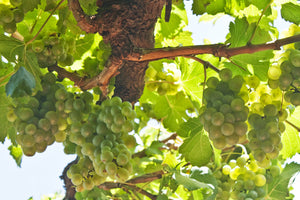Chardonnay is the most famous and widely planted white-wine grape in the world. It is known for its neutral taste and is often referred to as "the winemaker's grape" due to the fact that much of its flavor is amplified or reduced in the winery. Chardonnay wines have a light golden hue and can have notes of citrus, green apple, blossom, almonds, and oatmeal. The taste and aromas of Chardonnay are affected by climate, viticulture, and winemaking.
Climate plays a major role in the flavors of Chardonnay. The very coolest Chardonnay vineyards such as those in Chablis, Champagne and Germany, tend to produce green apple aromas and mineral notes like chalk, wet stones and crushed seashells. These notes are sometimes attributed to the soils in the vineyard. For example, the wines of Chablis often show Chardonnay at its most mineral, with little or no oak used in the winemaking process and notes of citrus, blossom, and chalk along with high levels of acidity. Chablis' famous Kimmeridigan, ancient oystershell, soils are often credited with this chalky minerality.
On the other hand, warmer regions like the New World, which includes countries like Australia or California, tend to produce more full-bodied Chardonnays with more body, fruit and palate weight, with exotic fruit notes and toasty oak on the nose. Countries like Chile, South Africa and Argentina also tend to give more tropical styles. Stylistically, most global examples of still, dry Chardonnay fall somewhere within this spectrum.
The wines of Burgundy are considered the benchmark for Chardonnay and strike a note that incorporates the minerality of Chablis and some of the power of the New World. These wines often incorporate oak and give intriguing, sometimes subtle stonefruit aromas with concentration of flavor and an impressively balanced and fresh length on the palate. For many Chardonnay lovers, from winemakers to wine enthusiasts, Burgundy remains the touchstone by which many a Chardonnay is judged.
In general, Chardonnay grows well in a variety of climates. It provides a relatively good yield and is relatively vigorous. However, the concentration of flavor in the final wine may involve a degree of crop-thinning in the growing season. Vines bud and flower early in the season, making them susceptible to spring frosts and viticulturists in cool climates such as Chablis and Champagne have to take extra care to protect their vineyards from frost. Additionally, Chardonnay can be affected by various vineyard pests and diseases, and winemakers have to be mindful of these when deciding on their viticultural approach.
Overall, Chardonnay is a versatile grape that can be grown in a variety of climates and can produce a wide range of flavors. The wines of Burgundy are considered the benchmark for Chardonnay, but the grape is also grown in other regions around the world, such as Wider France, Europe, and the New World. Each region produces its own unique style of Chardonnay, making it a fascinating grape to explore and discover.

